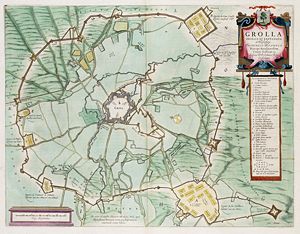Siege of Groenlo (1627)
| Siege of Groenlo | |||||||
|---|---|---|---|---|---|---|---|
| Part of the Eighty Years' War | |||||||
 Siege of Groenlo in 1627 by Frederick Henry, including the circumvallation. Map J.Blaeu. |
|||||||
|
|||||||
| Belligerents | |||||||
|
|
|
||||||
| Commanders and leaders | |||||||
|
|
(Spanish Army) |
||||||
| Strength | |||||||
| 16,000 infantry 4,000 cavalry |
1,200 infantry (Grol) 100 cavalry (Grol) 16,000 infantry (Spanish Army) 5,000 cavalry (Spanish Army) |
||||||
| Casualties and losses | |||||||
| Unknown | Unknown | ||||||
The Siege of Grol in 1627 was a battle between the Army of the Dutch Republic commanded by Frederick Henry, Prince of Orange and the Spanish controlled fortified city of Grol (now known as Groenlo), during the Eighty Years War in 1627. The Spanish army led by Hendrik van den Bergh came to relieve Grol, but it came too late. The siege lasted from 20 July until 19 August 1627, resulting in the surrender of the city to the army of the United Provinces.
During the siege, a 16 kilometer long circumvallation line was made around Grol in order to prevent the enemy from leaving and to prevent liberation of the city from the outside. Ambrosio Spinola had used a similar technique during the Siege of Breda (1624), and after the successful siege of Grol Frederic-Henry would later use it in other sieges in the Netherlands, such as at the Siege of 's-Hertogenbosch. The success at Grol provided the first serious victory on land for the Republic after the Twelve Years' Truce.
Even though it was only a small city, Grol was of military strategic importance. Grol was a flourishing trade center, well fortified and armed, and it had a strategic position on the Hanseatic trade route to Germany. The area around Grol was marshy and difficult to reach, and anyone in control of the city was in control of the region. Maurice of Nassau had taken Grol in 1597, after an unsuccessful try in 1595, and Spinola retook it in 1606. Maurice tried to take Grol again, later during the same year, again unsuccessful, after which Grol remained in Spanish hands until 1627. Grol provided a defensible place to garrison troops and a freehaven for Spanish raids. Heavy taxes and import duties were collected here from the whole of the Achterhoek and Veluwe, which provided a steady source of income for the Spanish war treasury. Together with the fortified towns of Oldenzaal, Bredevoort and Lingen, Grol could provide a base for attacking the republic from the east. This is why the States-General chose to invest in an army to capture Grol, instead of concentrating solely on sea battle with the Spaniards (which the powerful states Holland and Zeeland wanted).
...
Wikipedia
